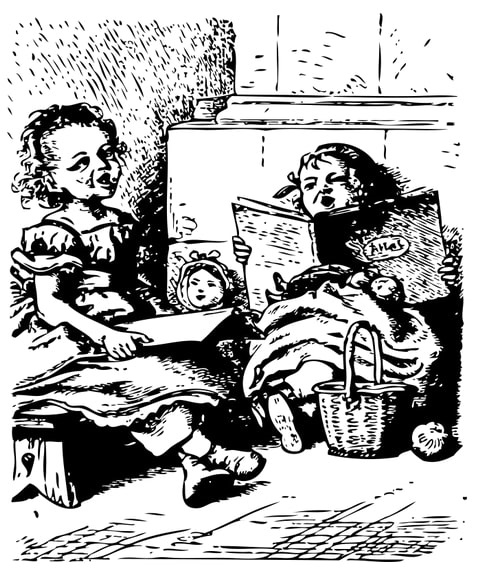Introduction: In this article, Jessica Edwards concludes her introduction to a new series exploring the pastimes and toys our ancestors enjoyed when they were children. Jessica has had a lifelong interest in her family’s history – especially on her father’s side, which goes back to the first settlers in Pennsylvania, Jamestown and New England – and has documented and added more than 21,000 people to her family tree!
In earlier times, young children had to help with housework. Then around the age of 9 or 10 they also started to work in the fields or in the factories – both boys and girls. Children were expected to do chores from almost sunup to sundown (to take some of the burden off their parents’ shoulders) from the age of roughly 5 years old until the time they married (many girls married between the ages of 15 to 22 and males usually between 20 to 26) and left to begin their own families.

Boys had many chores, from gathering and cutting wood for the stoves and fireplaces to tending livestock, building fences, helping in the planting and harvesting of crops, etc. – or working in factories. Girls also were kept busy, as they helped in the house by cooking, sewing, knitting, making soap and candles, tending younger siblings, washing clothes, etc. – and also worked in factories. The types of responsibilities for children changed depending on where they lived and their age – with more work being added the older they got. Children between 7 and 12 years of age comprised one-third of the factory workforce in earlier times.
Because of all the work they were expected to do, children didn’t have much “free time.” For when they did, most toys were homemade as few families could afford to buy toys and games. Pre-made toys were expensive and any available money was usually funneled back into things considered more important, like seed, lumber, cloth, etc., so toys were created by either the parents or the children from everyday items like barrel hoops, pebbles, branches, string, etc.
Some tasks on the farm became activities to share with neighbors, as people in a community worked together (like harvesting, building structures like barns and houses, slaughtering animals, cheese making, and quilting). After the shared activity was done, adults could visit with neighbors (another rarity) and children could play with others.
In comparison to most children today, children in earlier times didn’t have as much fun and free time. City children were permitted to play only after the household work was done, and most of them had to play indoors until some adult was free to take them outside (it was thought that unsupervised children might become wild and unruly, like poor street urchins). On the other hand, children in the country had wider options to choose, from activities like swimming to riding ponies, etc., with the little free time they had.
Parents wanted everything their children did to be educational and help improve their thinking. Some children were taught at home. If you were lucky, you might attend school at a schoolhouse until the eighth grade – unless your parents had money either for tutors or to send you to school for a longer period of time. Many games played by children in the 1800s were not only designed for fun, but also had a lesson or skill embedded in them. Some children’s activities had religious reasons behind what they did.
What sex a child was may have played a part in what games or activities they could participate in, or what toys they had to play with. For example, boys were generally expected to do things in their free time that were more “rough and tumble,” like sports. Some boys’ games, like hopscotch, are no longer considered boys’ games. (Hopscotch is generally played more by girls now than boys). Boys loved to play outside, so they might ask for a shovel (a favorite toy from the late 1800s). They also played outside with cloth or leather balls.
Girls played with a variety of toys in the 1800s, like a competitive game with a cup and ball (the objective was to see how many times you could catch the ball in the cup). Another game played by girls was rolling a hoop with a stick, seeing how far you could get it to roll without it falling. Other popular toys were dolls and dollhouses.
Gradually our country became more settled as houses grew closer to other homes, which then may have become towns and villages, which may have grown into cities. This change also brought about traveling peddlers, which morphed into small stores, which gradually grew larger (thereby offering more items).
Another development were mail order catalogues, which gave children ideas for creating their own toys and games, as well as provided parents a way to indulge their offspring at holidays and birthdays (if finances allowed – and you would be lucky to receive just one toy then, as well as a treat like an orange or nuts, and maybe a new piece of clothing). As late as 1977, the children in my family would fight over the various catalogues as they arrived. We made out “wish lists” that were revised numerous times as we read and re-read the catalogues, so that our parents might have an idea of what we would like.
In the upcoming articles in this series, I will be telling you as much as I can about how things were used or played with, and any history on their creation. For very popular games and toys, like the game of chess or baseball, I may write about them as a stand-alone article. In other articles I may write about five or more toys or games. So, take a look into the past with me as we look at how children played from 1700 to 1950.
Related Article:
